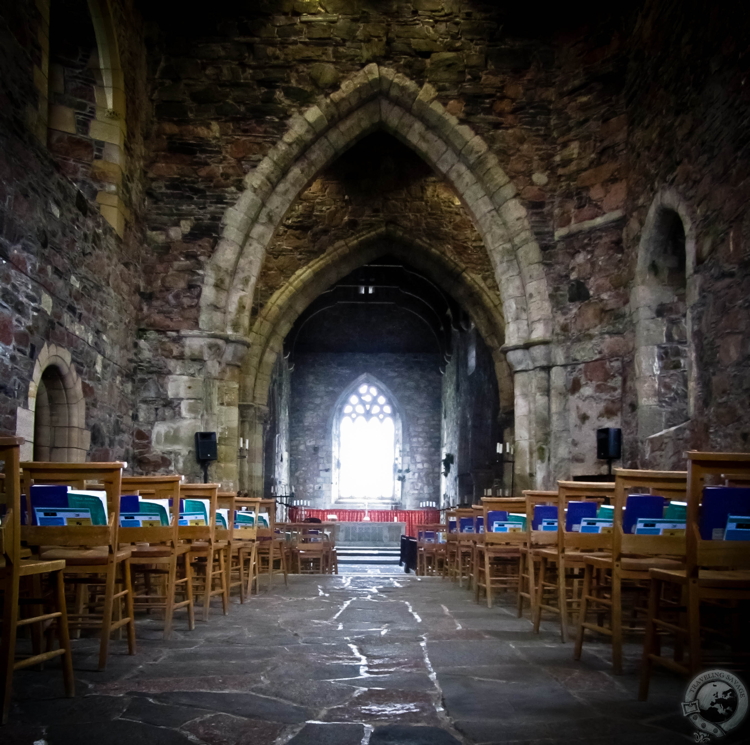The wooden door to the chapel slams shut behind me: A silent dimness opens up as the tempest battering Iona is closed off. Hard, simple chairs march toward a divine arched window all aglow, worn hymnals resting in the seat backs. Great pavers, damp from the Scottish autumn, jigsaw together on the floor. A cash register dings and chimes in a gift shop somewhere. Fifteen centuries ago, a building stood here that was Columba’s golem of faith. He launched sortie after sortie upon the native Picts and Scots from this scrap of land, determined to pave over their beliefs with his own: Christianity.
Into ruin and rebuilt, again and again, Iona Abbey was reborn and resurrected over the centuries. Each time an element of the original structure was ignored or forgotten until now, when what we’re left with is little more than 80 years old. Would Columba recognize today’s abbey? So I wonder about many things of antiquity that have lasted into our modern times. It seems our millennia-long games of telephone must send us in unforeseen, perhaps opposite, directions. My footsteps scrape along the stone as I make my way to the prayer corner. I strike a match and put a flame on a tealight, look out the barred window into the rain, and whisper a few words.


It must be an amazing feeling being in such a place, however much rebuilt and however different our sense of the holy or divine may be in today’s world. We are so driven by reason, empiricism, scepticism that I’m not sure we can really know what it must have meant to Columba and the religious, the missionaries of his day. Still, somehow, despite our kinship with Camus’ stranger, we feel something in the presence of this ancient mystery. Perhaps it’s just a cultural artifact that grips us, that creates that slight chill, tingle. Or maybe the humbling feeling that comes with a brush with what we cannot know empirically.
Couldn’t say it better myself.
Ah, Columba. I remember reading a Nigel Tranter yarn about the man. Fascinating period. Must get back to reading around it…
I love that sense of the elements being instantly shut out – via the distancing of outside noise, turned it into something heard in a dream. I was in Hexham Abbey (Northumberland) last week and experienced the same thing. You Shall Not Pass, written in stone.
And the rebuilding. That’s a truth of so much architecture in Britain – mongrels, fathered by many centuries. Iona has seen more turmoil than most. 80 years – wow. Blink of an eye.
But in a way, that’s part of the appeal – hunting for traces amidst the obviously new. Treasure-hunting.
Under Hexham Abbey is a crypt, and if you go down into it far enough, you’re in a room that’s 1400 years old. Unchanged, apart from a little repair work and whitewash. And at the end of one corridor, there’s a slab of stone in the ceiling. Carved letters, almost obliterated by age…and you can just make out the latin name “Marcus Aurelius”.
*Old*.
Hexham sounds awesome. I had the same kind of experience at Rosslyn Chapel, the owners of which won’t allow anyone to explore beneath it even though tests indicate there’s a sealed chamber there.
Iona is a special island, and the Abbey (rebuilt or otherwise) is a wonderful focal point – even walking along the Street of the Dead, with over 50 kings buried around you, gives you sense of the history of the place: I Chaluim chille (the Island of Columba of the Church). I grew up in Dunkeld in the Perthshire Highlands, and it was to an ancient monastery here that Columba’s remains were brought to protect them from the Vikings. Today a 700 year old cathedral sits on the site, and more than one historian and comentator has said that in no other place do you feel the old Celtic church, and hear the voices of her myriad of saints than in Dunkeld Cathedral. Here Iona’s ancient legacy has been preserved in stone and mortar. Well worth a visit if you’re in that part of the world.
I have been to Dunkeld and its cathedral on several occasions. In fact, Dunkeld is one of my favorite places in all of Scotland! How cool that you grew up there! I felt something much stronger at the Dunkeld Cathedral than at Iona Abbey.
Hi Keith,
Yes, I was very lucky to grow up in Dunkeld (my parents are still there); and I was married in the Cathedral – one of our favourite pictures is us leaning on the tomb of the Wolf of Badenoch. You are not wrong about the atmosphere of the place. I wrote an article on the Diocese of Dunkeld (pre-Reformation) for the Clan Donnachaidh magazine – I’ll e-mail it to you for your own enjoyment.
David